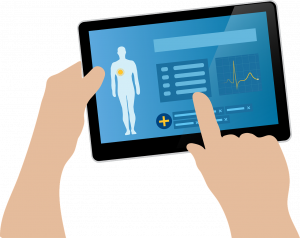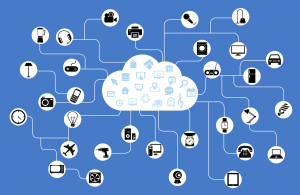19 The Analysis of Blockchain Technology
Sierra Rosado
19.1 Introduction
Keywords
- Blockchain – a type of decentralized database system based on linking together previous records in secure blocks of information
- Artificial intelligence – a computer, robot, or other programmed mechanical device having this humanlike capacity
- Analysis – this process as a method of studying the nature of something or of determining its essential features and their relations
- Depiction – representation or characterization in words
- Ledger – a record keeping system
- Cryptocurrency – type of currency which uses digital files as money
- Bitcoin – a decentralized digital currency that you can buy, sell and exchange directly
- Nodes – a basic unit of a data structure
- Latency – a measure of delay
- IoT – a system of interrelated, internet-connected objects that are able to collect and transfer data over a wireless network without human intervention
- Gem – a network for developing applications and shared infrastructure for healthcare
- Integration – to form, coordinate, or blend into a functioning or unified whole
Learning Objectives
By the end of this chapter, students should be able to:
- Understand the development of blockchain technology within the medical field.
- Discuss the impacts blockchain technology has in the healthcare industry.
- Describe the overall role and effect blockchain technology has on society.
- Provide insight to the futuristic potential this technology could have on our society with the involvement of the medical field
Blockchain technology is an important innovation in our society that provides us with an easier way of providing care in the medical field. Blockchain technology is one of the newer technologies being implemented into our healthcare system that benefits not only healthcare workers but patients as well. This technology in the medical field has affected society in a positive manner as it provides efficiency for those who use it (Mettler, 2016). While society should not depend on blockchain technology for work, this technology is one that has contributed to advancements in the medical field as it protects and secures medical files, provides us with a more accurate depiction on patients, and efficiently manages medical supplies.
Within this chapter, we will discuss the origin of block chain technology, the development of the technology over time, how block chain technology works, the future possibilities, and the overall impact this technology has on society. This technology allows society to have the advantage to restrict access to those not allowed to obtain the secured information. The development of our blockchain security has created a convenience and has helped to build a technology that society can fully rely on.

.“BlockChain Technology Contributions” by Max Pixel is licensed under Public Domain, CC0
19.2 What is Blockchain Technology?
Key Takeaway
Blockchain technology has provided us with a newer, more effective system that allows the transfer of patients’ medical data in the safest way possible. The healthcare industry uses this innovation to its full advantage as it meets the privacy requirements necessary for any healthcare setting.
Blockchain technology is a system that records and secures information primarily used in the healthcare system. It provides us with an advanced way to efficiently organize by creating a network, or chain, of records of patient files, patient histories and descriptions, and medical supplies (Mettler, 2016). Overall, this technology provides the most secure environment that helps to maintain and store health information.
Blockchain technology has been described as similar to artificial intelligence as it has the ability and capacity to store extensive amounts of information over a private network that helps to resolve the issue of authentication. This information is then stored in a chain of networks within computers (Elsevier, 2021). Consider the amount of times the average person changes health insurances, doctors, or even the hospital they receive care from. Blockchain allows for the quick transfer of medical information from one place to another and the ability to maintain data and history on a patient.
To ensure the safety and security of this technology there are three main processes taken to test the reliability of blockchain. The first step involves the integration testing of the blockchain testing. Integration testing tells us if this technology is compatible with medical file systems already in place and if the transition to blockchain would be secure and without any issues. It also tells us if we are to have the ability to communicate easily with this technology in an accurate manner. Next, the testing of the network nodes, the basic units of the network structure, meets the protocol for the correct authentication of security necessary for medical information. Every single node’s function is checked in order for it to fully function properly in the healthcare industry. The final step is to check for the network latency, the measure of delay the network may experience, as it tells us how the performance of the blockchain system will be (Mashatan, 2020). This is vital to ensure that patients and workers are able to securely share medical information.

“Medical Information Privacy and Protection” by Max Pixel is licensed under Public Domain, CC0
19.3 History of Blockchain Technology
Key Takeaway
The development of blockchain technology was not intended for the healthcare industry, but as it became a success in other sectors, it then became widely accepted and used in many different ways. The use of this technology has created convenience in society by allowing us to protect our information with confidence.
Blockchain technology was first introduced to be used in cryptocurrency and bitcoin in 2008. At first this innovation provided society with a ledger that was more accurate than ever before. Although it started with bitcoin, it gained attention outside of this industry as well (Mashatan, 2020). Blockchain instilled trust within the public as this was the first time people were able to track their data on transactions (Elsevier, 2021). Satoshi Nakamoto, one of the founders of bitcoin, understood the importance of establishing a network of trust and in 2008 published an article explaining to society the connection between security and blockchain technology within the bitcoin industry (Yoon, 2021). As more and more people began to build trust in this machinery, it quickly became the primary security system within the bitcoin industry.
It was not until 2012 that this technology was incorporated into the healthcare industry as many people were advocating for it. This innovation started to gain attention because of its ability to distribute information securely. Blockchain technology was used in the healthcare industry as people found themselves struggling to create a solution for the overload of work that came with maintaining medical files for many patients in a secure manner (Mashatan, 2020). This innovation quickly was encouraged to be used within the healthcare industry to not only support healthcare workers but also the patients themselves.
Blockchain promised a way for any industry to improve business outcomes and to capture new potential sources of profit. However, the most important implementation of this innovation is the healthcare field. Blockchain was developed into hospitals and even physician care institutions. This technology was starting to bring people closer together as they felt secure in medical care. Statistics indicate that about 1 in 5 hospitals now have blockchain technology as it has expanded across the medical industry very quickly (Mashatan, 2020). This technology will continue to grow larger in the field because it is becoming more familiar and advocated for not only by medical workers but by society as well.
19.4 Blockchain Technology’s Impact on Society
Key Takeaway
There are many challenges and opportunities that come along with the use of block chain technology in our society. It is important to understand how both the benefits and negative effects of this technology potentially have on society.
19.4.1 Opportunities created with Blockchain Technology
Blockchain technology creates many benefits for patients and healthcare providers by including an enhancement of security, privacy, and putting patients as the main priority. The medical data management system that has been created has enhanced how quickly and accurately we are able to create a depiction of patients. The technology has been proven to lower costs and improve patient care and outcomes as it creates a better use of healthcare data within the medical field (Attaran, 2020).
Because it allows the healthcare industry to continuously handle many types of information such as DNA data, personal information, and medical history, block chain has transformed the area of organ transplants. By providing a more accurate match which makes the transplants simpler and safer than ever (Attaran, 2020).
Just as the healthcare industry is able to access these documents, patients also have the ability to manage their own records anywhere at any given time. This storing of information guarantees the best service possible as there is no doubt of privacy for people. This innovation allows us to access and share patient medical records with a guaranteed restriction of the information.

“Medical Information at our Grasp” by Max Pixel is licensed under Public Domain, CC0
19.4.2 Challenges faced with Blockchain Technology
One of the main challenges society faces with blockchain technology is that it is continuously being redeveloped and redefined in order to meet the highest expectation of security in the healthcare industry. While this innovation is able to retain so much information, eventually there is a limitation due to data storage. The data storage can only hold a certain amount of information and has led to cases of information decay because of the over capacity of data in it (Attaran, 2020). The healthcare industry has adapted to relying on this technology and therefore takes advantage of the fact that it can complete work easier and faster than the average person.
While this technology has been known to lower costs for the healthcare industry, it has also shown to increase it in certain aspects as well. Some hospitals or healthcare businesses simply cannot afford to maintain the full effect of blockchain technology, and are left to continue with the securing of information themselves (Attaran, 2020). However, as this technology has become more popular, it is being pushed as the primary security system for all healthcare industries to use. This causes those who simply cannot afford the machinery behind.
19.5 A Future Outlook on BlockChain Technology
Key Takeaway
The security system this innovation provides in the healthcare industry is promising as it is already furthering in growth as it continues to transform the industry. The future will hold much potential for this technology as advancements are already being made to continue its development.
It is likely that this technology shows that it will continue to provide the best security possible as data shows that many organizations are wanting to combine their technologies with this one to create an even more advanced way of securing information. IoT, Internet of Things, is the next step innovators are willing to incorporate with blockchain because it would allow us to extend information to not only blockchain systems but to smartphones, wearable devices, smart homes, and more (Benlamri, 2019) . This would also allow us to interact with one another virtually and have the ability to communicate through devices. During a time, such as a pandemic, this would be very helpful for those who are unable to meet with doctors as the medical files and history can be fully accessed from anywhere (Haleem, 2020). Furthermore, IoT would provide us with an even higher security than blockchain has now which is important if we are to add more files into these systems. This system combined with blockchain would create an even more advanced network that not only depicts and recognizes what specific medicines are needed based on the patient but also organizes the medicine supply (Mashatan, 2020). IoT and blockchain together are more cost efficient as well and altogether could help save millions of dollars within the healthcare industry.
It is possible that this technology could also potentially create a newer, more intelligent healthcare system for patients. For example, would enable researchers to easily find more specific aspects of patients with chronic diseases (Mashatan, 2020). It seems likely that our society would become completely dependent on this technology as it would establish a system that saves more time and resources but also beneficial changes in communication in healthcare. The Gem has already initiated a platform similar to such that has produced the capacity to track patients and their latest medical interactions. However this company imagines that a collaboration of their network and block chain technology’s great benefits for the medical field would allow for the building of a new healthcare infrastructure, all under blockchain.
Society will continue to use blockchain technology throughout the years if it is to continue to remain effective and advance not only the healthcare industry but also in the way in which people are able to work easier. The potential that blockchain has is endless but it is sure that society will want it to extend the growth and development of this innovation.

.“Blockchain Creates Medical Networks in Society” Created by Max Pixel is licensed under Public Domain, CC0
Case Study: Working Alongside Blockchain
Sarah is a newly graduated medical student from School of Medicine of Greenville ready to jump into the medical field. Within the first couple of weeks of working, Sarah finds that the hospital she works at does not have nearly as advanced technology as others do. Sarah also finds herself spending more time filing medical information than actually spending time with the patients and realizes how time consuming it is becoming. Sarah notices she simply cannot keep up with the amount of paperwork and the amount of time she needs to take care of clients and feels as if she should make a change.
Sarah speaks with other graduates from her class and explains to them her level of stress that comes from simply trying to manage patient information in a secure and efficient way. As these graduates are located in a different hospital, they explain to her how their hospitals implemented blockchain technology to make their work easier for them. Sarah comes to the conclusion that if she wants to experience the full extent of being a doctor, she would have to transfer to another hospital.
As Sarah then transfers and now works at a different hospital that has blockchain technology, she finds herself having more time to complete other tasks as opposed to spending time on just one. Sarah realizes that blockchain technology is much faster and more efficient in work than she was in filing medical information and takes advantage of this innovation to the full extent. Sarah continues to stay at this hospital where she is now able to balance her work in a positive manner with less stress than before.
Chapter Summary
Blockchain technology has revolutionized the way in which we are able to provide reliable patient information in the medical field. It has made data more accessible for workers and patients which overall creates a boundary of comfort and trust between the two. Despite the downsides of this technology, it is still becoming more modernized today in order to keep up with societal needs. Blockchain technology is the most modernized network in our healthcare industry to help secure medical information in the most accurate and efficient manner. This innovation was developed alongside bitcoin as many people saw positive results from bitcoin then implemented into our medical field. Blockchain within our healthcare industry has created advantages such as improving patient care, lowering costs, and even accurately matching organs. However, setbacks were also created from this technology including a limitation in data storage, reliability of this technology, and even affordability. The future outcomes for this technology are endless as the technology is already becoming more familiar in healthcare and requested more by society. Blockchain technology will continue to be developed throughout the years simply because the healthcare industry has benefited entirely by utilizing it and it creates an overall positive effect for people.
Review Questions
1. Which is a limitation of blockchain technology?
A. Hospitals do not care for this technology
B. Not enough data storage for extensive amounts of information
C. The technology does not correlate with medical information
D. Blockchain is frown upon by society
2. Which is an opportunity created with blockchain technology?
A. More patients are provided with security
B. Organ transplants
C. All of the above
D. Cost effective
3. Why is it important to have this technology in the healthcare industry?
A. To secure information
B. To manage medical supply
C. To provide efficient patient care
D. All of the above
4. Blockchain technology was initially used for what?
A. Bitcoin
B. Medical files
C. Schools
D. The government
Answers:
- B
- C
- D
- A
Food for Thought
- Do you think that this technology could lead to a total dependence on the machinery or will the healthcare industry correlate it with hands-on work as well?
- In the future, could you see only specific healthcare places able to obtain this technology or will it eventually become a global or worldwide advantage?
References
Attaran, M. (2020). Blockchain technology in healthcare: Challenges and opportunities. International Journal of Healthcare Management, 1–14. https://doi.org/10.1080/20479700.2020.1843887
Elsevier. (2021). Medi-Block record: Secure data sharing using block chain technology. 2021. https://doi.org/10.1016/j.imu.2021.100624
Farouk, A., Alahmadi, A., Ghose, S., & Mashatan, A. (2020). Blockchain platform for industrial healthcare: Vision and future opportunities. Computer Communications, 154, 223–235. https://doi.org/10.1016/j.comcom.2020.02.058
Khezr, S., Moniruzzaman, M., Yassine, A., & Benlamri, R. (2019). Blockchain Technology in Healthcare: A Comprehensive Review and Directions for Future Research. Applied Sciences, 9(9), 1736. https://doi.org/10.3390/app9091736
Mettler, M. (2016). Blockchain technology in healthcare: The revolution starts here. 2016 IEEE 18th International Conference on E-Health Networking, Applications and Services (Healthcom). https://doi.org/10.1109/healthcom.2016.7749510
Sharma, A., Bahl, S., Bagha, A. K., Javaid, M., Shukla, D. K., & Haleem, A. (2020). Blockchain technology and its applications to combat COVID-19 pandemic. Research on Biomedical Engineering. https://doi.org/10.1007/s42600-020-00106-3
Yoon, H.-J. (2019). Blockchain Technology and Healthcare. Healthcare Informatics Research, 25(2), 59. https://doi.org/10.4258/hir.2019.25.2.59
A type of decentralized database system based on linking together previous records in secure blocks of information.
A computer, robot, or other programmed mechanical device having this humanlike capacity.
To form, coordinate, or blend into a functioning or unified whole.
A basic unit of a data structure.
A measure of delay.
Type of currency which uses digital files as money.
A decentralized digital currency that you can buy, sell and exchange directly.
A record keeping system.
Representation or characterization in words.
A system of interrelated, internet-connected objects that are able to collect and transfer data over a wireless network without human intervention.
A network for developing applications and shared infrastructure for healthcare.

